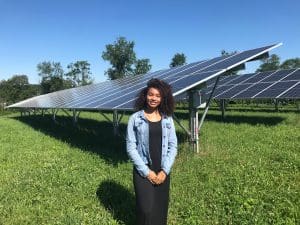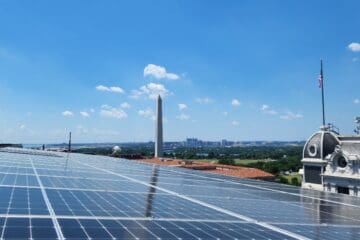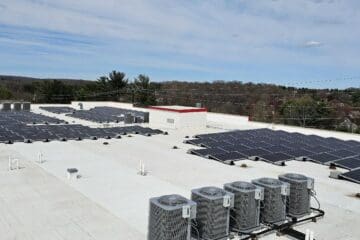Here are answers to three questions we hear all the time from prospective customers about commercial solar. Have more questions? Let us know, we'll be happy to answer them!
As a solar salesperson I have the privilege to speak to many people daily about how their specific properties can benefit from solar installation. At Aurora Energy we focus mainly on commercial and industrial rooftops, and buildings owners in this market often have similar questions and concerns about going solar. In this blog I want to take a moment to address some of the most common questions that I get from building owners considering solar installation.
1. Will a solar installation damage building’s my roof?
Each roof is unique and there are many different types of solar racking that we use to secure a solar installation. Broadly speaking there are two methods to make sure your panels stay put.
- Ballast: Many flat roofs that are below the 60ft height range are great candidates for a ballasted racking system. With this type of racking, no rooftop penetrations are required. Instead, racking is kept in place with ballast block that look like common concrete paving stones. This arrangement is great because it avoids any roof penetrations. Additionally, we at Aurora always complete a structural analysis of the roof to ensure it can support the required amount of ballast to hold the solar installation in place.
- Mechanically attached: Many other flat roofs that are over 60ft in height (and basically all pitched roofs) will require mechanical attachments or roof penetrations to affix solar to the building. Building owners are understandably often concerned that any penetrations on their roof will lead to leaks. However, the good news is that through millions of installations and decades of experience the solar industry has developed both the hardware in cooperation with roofing manufacturers to minimize this risk. When we at Aurora begin a project, we always consult with the existing warranty holder for the building and work with them to ensure that any existing roofing warranties will be upheld. Additionally, the way that solar attachments are done is like how any other rooftop mechanical attachment for equipment like HVAC or piping is carried out. Our attachments are flashed and sealed in accordance with the roofing manufacturers’ best practices.
Generally speaking, the chances that a solar installation – performed by a qualified installer – will cause roof damage, is extremely small.
2. What are financing options for solar?
- There are several attractive options on solar project financing, the most common being a Power Purchase Agreement or PPA. In this arrangement a building owner agrees to allow a third-party financial institution to build and then own a solar array on their property. They then sign a contract with this financial institution to buy all of the electricity produced by the solar installation at a discount to their existing utility bills. The building owner gets a solar installation completed on their property for no-upfront costs and gets to enjoy immediate utility bill savings from the system.
- A second option is to purchase, where building owners can choose to pay for the construction costs of the installation themselves (or take a loan) and reap all of the financial benefits that comes with solar installation. With a purchase, building owners don’t just get electricity bill savings, but also Solar Renewable Energy Credits (SRECs), state & local incentives, and tax benefits such as the 26% Federal solar Investment Tax Credit (ITC). Most systems in the mid-Atlantic region can provide a strong return on investment and a payback within 4-8 years on a 25-year warrantied solar installation.
- Some key consideration when deciding between these options include the following:
- Do you have enough taxes to be able to fully use the tax benefits that come along with solar installation? If you are a non-profit, then you probably don’t have enough tax liability to benefit from a purchase. If you don’t have sufficient tax liability and you are installing a 200kW solar system and above it can often make more sense to go with a third party ownership structure such as a PPA.
- Do you have cash on hand? As mentioned above, solar installations provide a great return on investment and have a better IRR than many other types of capital improvements. However, if cash flow is tight, it can often be easier to have a third party own the system. If cash is available, always consider that system ownership will give the greatest financial return.
- Are you comfortable dealing with maintenance? One of the biggest perks of a PPA is that the financial institution that owns the solar array will handle any needed Operation and Maintenance (O&M) for the installation. This provides peace of mind for many building owners who don’t want to be bothered with ongoing O&M contracts or checking on system performance on their own. That said, for clients who are comfortable owning assets and managing maintenance contracts, taking on solar O&M is not very daunting. Solar installations have no moving parts and can be maintained at a low cost by qualified vendors.
3. I have high electrical usage and a small roof, should I still consider solar installation?
- I encourage building owners to shift their mindset here and instead of focusing on how much solar can offset their electricity bills instead focus on the return on investment of solar installation. Even if a PV system only offsets a small percentage of building usage the return on investment can be very high.
- Overall, there are three primary revenue streams from solar: 1- Offsetting existing electricity costs, 2- Solar Renewable Energy Credits or SRECs, 3- Tax Benefits. Even if a company can only offset say 10% of their total electrical usage the combination of these three revenue streams can still add up to a very profitable investment. Therefore, instead of considering solar as a way to eliminate all utility bills (although given larger roof spaces, this is often the case) it useful to consider solar installation in terms of a capital expenditure that returns a great profit for the system owner.
These are just three of the most common questions that I receive from building owners, and I hope you have found the answers useful. It is important to emphasize that each solar project is unique and will come with its own set of questions, challenges, and opportunities. Luckily, with a depth of experience going back to 1994, Aurora Energy is prepared to guide property owners through any site-specific circumstances and devise a clean energy solution that allows for maximum production and delivers financial results.






